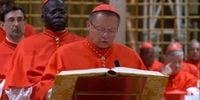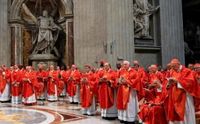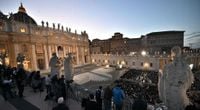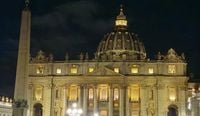The Vatican is currently witnessing one of the most significant ceremonies in the Catholic Church, as the conclave commenced on May 7, 2025, to elect a new pope. A record 133 cardinal electors from 71 countries are participating in this historic event, including four from Poland: Stanisław Ryłko, Kazimierz Nycz, Konrad Krajewski, and Grzegorz Ryś.
The solemn procession of the cardinal electors to the Sistine Chapel marked the beginning of the conclave. Dressed in traditional red choir robes, the cardinals made their way from the Pauline Chapel, accompanied by a prayer and the hymn "Veni Creator," invoking the Holy Spirit for guidance. Upon arriving at the Sistine Chapel, the cardinals took a solemn oath to uphold the apostolic constitution "Universi Dominici gregis," established by Pope John Paul II, committing to maintain strict secrecy regarding the election process and to remain faithful to the newly elected Bishop of Rome.
After taking the oath, unauthorized participants were asked to leave the Sistine Chapel, isolating the electors from the outside world. The first vote took place on the same day, but it did not yield a resolution, as indicated by the black smoke that rose from the chimney at 9 PM. This traditional signal confirmed that the cardinals had not yet elected a new pope.
On Thursday, May 8, 2025, the second day of the conclave, four votes are scheduled: two in the morning and two in the afternoon. If the first morning vote results in the election of a new pope, white smoke is expected to emerge around 10:30 AM. If the second vote is successful, white smoke will appear around 12:30 PM, followed by a lunch break. The afternoon votes will conclude with potential smoke signals around 5:30 PM and 7:30 PM.
As the world watches, the Catholic community is eager to witness the white smoke that will announce the election of a new Holy Father. The conclave will continue until one of the candidates secures the required two-thirds majority of votes, meaning at least 89 votes out of 133 electors.
Among the candidates for the papacy are several prominent figures. Cardinal Pietro Parolin, the Secretary of State of the Holy See, is considered a strong contender. Other notable candidates include Cardinal Francis Prevost from the USA, Cardinal Jean-Marc Aveline from France, Cardinal Pierbattista Pizzaballa from Italy, Cardinal Matteo Zuppi from Italy, and Cardinal Angel Fernandez Artime from Spain. The presence of such a diverse group of electors reflects the global reach of the Church.
The current conclave is notable not only for its size but also for the historical context in which it is taking place. This is the third conclave in over two decades, following the elections of Pope John Paul II in 2005 and Pope Benedict XVI in 2013. The decision-making process is shrouded in secrecy, with the cardinals isolated from the outside world to ensure the integrity of the election.
As the hours pass, anticipation builds in St. Peter's Square, where about 45,000 people gathered to await the outcome of the first vote. The wait lasted over three hours, a testament to the high number of electors, which is the largest in history. The last conclave in 2013 had 115 electors from 48 countries, highlighting the efforts made by Pope Francis to broaden the Church's global representation during his pontificate.
Once a new pope is elected, the protodeacon will announce to the world from the balcony of St. Peter's Basilica: "Annuntio vobis gaudium magnum: habemus papam" (I announce to you a great joy: we have a pope). The new pope will then appear on the balcony, offering his first blessing to the faithful.
The conclave's proceedings reflect both a deep respect for tradition and the Church's adaptability to contemporary challenges. The cardinals are reminded of their sacred duty not only to their faith but also to the millions of Catholics around the world who await their decision with hope and anticipation.
As the conclave continues, the Catholic Church stands at a pivotal moment in its history, with the potential for a new leader to guide it through the complexities of modern society. The coming days will reveal not only the identity of the next pope but also the direction the Church will take under his leadership.


![Konklawe 2025 trwa. Jest 4 polskich kardynałów [PROCEDURA krok po kroku]](https://thumbor.evrimagaci.org/DZaFpkOTiG7QG82Dyd3HeP8hJNE=/200x0/tpg%2Fsources%2F8fc38a24-a8fc-41f7-b2da-942ebcd8600d.jpeg)


